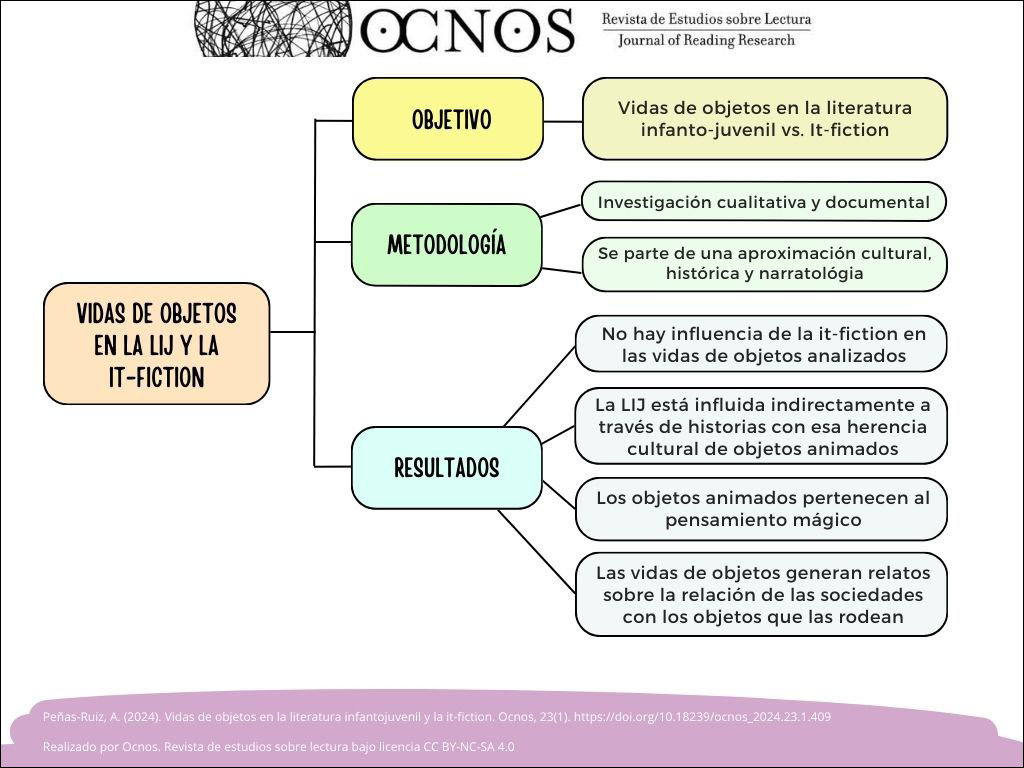Lives of objects in children’s & young adult literature and it-fiction
Main Article Content
Abstract
In this work, a corpus of lives of objects in recent Children’s & Young adult literature is compared with it-fiction, a narrative subgenre from the 18th and 19th centuries initially intended for adults, but which experienced a displacement of its audience. Based on the analysis of their thematic and formal connections, the philosophical, aesthetic and cultural links between these productions are evidenced, especially in terms of symptoms and narratives of the bond that societies establish with the objects that surround and configure them. As we will see, the unique characters of these works transcend their materiality and question readers about the link between human beings and artifacts, about globalization and about the consequences of capitalism in post-industrial societies. Finally, the research carried out allows us to compare two literary systems and the convergence between their reading audiences, a fact of interest in the field of the history of reading and reading practices.
Article Details

This work is licensed under a Creative Commons Attribution-NonCommercial-NoDerivatives 4.0 International License.
The articles published at Ocnos will have a Creative Common Licence Creative Commons Attribution-Noncommercial-No Derivative Works 3.0 Unported
Downloads
References
Blackwell, M. (2004). Extraneous bodies. The contagion of live-tooth transplantation in late-eighteenth-Century England. Eighteenth-Century life, 28(1), 21-68.
Blackwell, M. (Ed.) (2007). The secret life of things. Animals, objects, and it-narratives in Eighteenth-Century England. Bucknell University Press.
Blake, Q. (s.f.). Inspirations. Quentin Blake. En Teachers TV, Quentin Blake. Power of Illustration. https://vimeo.com/249644268
Brown, B. (2015). Other things. The University of Chicago Press.
Cuvardic-García, D., & Cerdas Fallas, M. (2020). La enunciación de objeto en Catulo, Horacio y Marcial. Revista de filología y lingüística de la Universidad de Costa Rica, 46, 191-205. https://doi.org/10.15517/rfl.v46iEspecial.41587
Cuvardic-García, D. (2019). Enunciación de objeto y minificción en la literatura costarricense: Artefactos, de Rafael Ángel Herra. En D. Hernández, J. A. Ramos Arteaga, & N. Mª. Concepción Lorenzo (Coords.), Dentro de la piedra. Ensayos sobre minificción y Antología (pp. 71-83). Servicio de Publicaciones, Universidad de La Laguna.
Escámez-Sánchez, J. (1998). Ética y educación ambiental. En P. Aznar-Minguet (Coord.), La educación ambiental en la sociedad global (pp. 14-27). Universitat de València.
Ferreira-Boo, C. (2017). El personaje en el cuento maravilloso: la subversión de arquetipos femeninos de brujas, princesas y hadas. AILIJ, 15, 41-56. https://dialnet.unirioja.es/servlet/articulo?codigo=6267724
García-Padrino, J. (2003). Las lecturas infantiles. En V. Infantes, F. López, & J.-F. Botrel (Dirs.), Historia de la edición y de la lectura en España 1472-1914 (pp. 735-744). Fundación Germán Sánchez Ruipérez.
Moja, B. (2016). Children’s Literature: testi minore per una letteratura maggiore. An Introduction to It Narratives. Universidad degli Studi di Milano. https://www.academia.edu/24917871/An_Introduction_to_It_Narratives
Latouche, S. (2014). Hecho para tirar: la irracionalidad de la obsolescencia programada. Octaedro.
Manguel, A. (2023). Una historia de la lectura. Alianza Editorial.
Nicolopoulou, A. (2008). Rethinking character representation and its development in children’s narratives. In J. Guo, E. Lieven, N. Budwig, S. Ervin-Tripp, K. Nakamura, & S. Özçalişkan, Crosslinguistic approaches to the psychology of language. Research in the tradition of Dan Slobin (pp. 241-251). Psychology Press.
Nikolajeva, M. (2014). Retórica del personaje en la literatura para niños. FCE.
Nikolajeva, M., & Scott, C. (2006). How picturebooks work. Routledge.
Nobile, A. (2007). Literatura infantil y juvenil: la infancia y sus libros en la civilización tecnológica. Ediciones Morata y Ministerio de Educación y Ciencia.
Noguerol-Jiménez, F. (2023). Francisco Tario y la narrativa del ello. En R. García-Gutiérrez (Ed.), Todos los caminos conducen a Rulfo. Itinerarios del cuento mexicano desde el modernismo a El Llano en llamas (pp. 337-356). Peter Lang. https://gredos.usal.es/handle/10366/153093
Nowka, S. (2015). Objects narratives. In G. Day, & J. Lynch (Eds.), The encyclopedia of British literature 1660-1789. Vol. 3 (pp. 847-849). John Willey & Sons.
Parada, A. E. (2019). Lectura y contralectura en la Historia de la Lectura. Eduvim.
Peñas-Ruiz, A. (2017). Miradas de lo insignificante. De la it-fiction a las nuevas formas de hacer historia. En J. M. González, M. L. Sotelo, M. Cristina, H. Gold, D. Thion, B. Ripoll, & J. Cáliz (Eds.), La historia en la literatura española del siglo XIX. VII Coloquio (Barcelona, 22-24 de octubre de 2014) (pp. 489-508). Edicions de la Universitat de Barcelona. https://www.edicions.ub.edu/ficha.aspx?cod=08564
Peñas-Ruiz, A. (2012). La circulación de formas y técnicas narrativas: sobre it-fiction y cuento de objeto. En P. Botta (Coord.), L. Silvestri, L. Frattale, & M. Lefevre (Eds.), Rumbos del hispanismo en el umbral del Cincuentenario de la AIH, 5. Moderna y Contemporánea (pp. 497-508). Bagatto Libri. https://dialnet.unirioja.es/servlet/articulo?codigo=7533106
Price, L. (2013). How to do things with books in Victorian Britain. Princeton University Press.
Shavit, Z. (2009). Poetics of children’s literature. University of Georgia Press.
Vermeule, B. (2010). Why do we care about literary characters? Johns Hopkins University Press.
Villanueva, D. (1991), El polen de ideas: teoría, crítica, historia y literatura comparada. PPU.
Textos primarios
Balmaseda, J. (1863). Memorias de una muñeca. La educanda. Periódico de señoritas, 20-32, del 30 de abril al 31 de julio.
Blake, Q. (2017). Clown. Gallimard. 1ª ed. original 1995, Jonathan Cape.
Capdevila, R. (1982). La máquina de coser. Destino.
Ende, M. (2001). El pequeño títere. SM. 1ª ed, original. 1995, Thienemann.
Müller, J. (2005). El soldadito de plomo en dibujos, basado en el cuento de Hans Christian Andersen. Lóguez. 1ª ed. original 1992. Harper Collins.
Sánchez Biedma, J. (1868). Aventuras de una silla contadas por ella misma. El Museo Universal, XII, 40-43, 45, del 4 de octubre al 8 de noviembre.
Unguerer, T. (2011). Otto. Autobiografía de un osito de peluche. Ediciones B. 1ª ed. original 1999, Ecole des Loisirs.
Victor, S. (2003), Ado-ka-frè. Chours.

